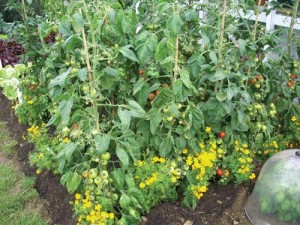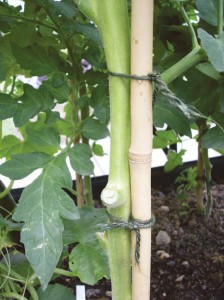Top Tomatoes
Top Tomatoes 1 2
Planting them out
It will be about seven weeks from sowing before your young tomato plants will be big enough to  transfer to their final growing positions. At this stage they should be at least 15cm tall with a number of healthy, adult leaves. Planting out needs to be carefully timed with the last frosts if you plan to grow your toms outside; work back from the usual date of the final frost – mid to late May in the Peterborough area – and sow accordingly. In most instances this will mean sowing in early April, but sowings can be made in March for greenhouse crops. Gradually harden the plants off before planting out by standing them out in their new home for progressively longer spells over a two-week period.
transfer to their final growing positions. At this stage they should be at least 15cm tall with a number of healthy, adult leaves. Planting out needs to be carefully timed with the last frosts if you plan to grow your toms outside; work back from the usual date of the final frost – mid to late May in the Peterborough area – and sow accordingly. In most instances this will mean sowing in early April, but sowings can be made in March for greenhouse crops. Gradually harden the plants off before planting out by standing them out in their new home for progressively longer spells over a two-week period.
To plant tomatoes directly into prepared soil simply scoop out a hole large enough to accommodate the rootball and position it into the hole before backfilling with soil and firming in. Space plants at least 45cm (18in) apart. Vine tomatoes will need ample support, so position a 1.8m (6ft) cane at planting time and loosely tie in the young plant to this using string or gardening twine. Ring culture can prove a valuable addition here. This is when a bottomless pot (the ring) is filled with compost/soil mix and positioned on top of the soil surface. The young tomato is then planted into this, raising it up from ground level to help drainage. The ring will also make watering much easier, trapping each drenching and enabling it to seep through without running away over the soil surface. Similar techniques can be applied to grow bag cultivation, thereby increasing the volume of soil the tomato roots have to spread into and creating a more stable environment.
Grow bags are very easy to plant up and can be located just about anywhere – in the greenhouse, on the patio or on a balcony. It’s worth taking the time to thoroughly ‘massage’ the bag before use in order to break up any clods and even out the compost throughout the bag. Once you’ve done this, cut away slits in the bottom to aid drainage and make slits in the top, as indicated on the bag, to receive the plants. Extra support can be given to plants by placing the bags over open soil so the deeper roots can break through the bag and better anchor themselves. If you want to grow tomatoes in containers then make sure each pot is at least 30cm in diameter. Use a mix of multi-purpose compost and a soil-based compost, such as John Innes, which will stop the compost drying out so quickly. In all cases plant the tomato plants slightly deeper than you might other plants. By burying part of the stem you will encourage plants to send out more roots, which ultimately makes them sturdier.
TOP TIP: Cover newly planted tomatoes with a sheet or two or fleece for a week following planting. This will ease the transition to their final growing place.
Looking after plants
 The main task now is to keep plants well watered. Don’t saturate them but equally make sure the compost or soil never fully dries out (this can cause fruits to split when you come to re-wet the compost). Once the first flowers appear begin feeding plants with a liquid tomato feed to encourage fruit production. Feeds are normally applied once a week when watering. If the first flowers of the summer are having difficulty setting fruit, mist your plants or gently tap the flowers to dislodge pollen and encourage fertilisation. Keep whitefly – a common pest of greenhouse plants – at bay by planting bright French marigolds in among the tomatoes.
The main task now is to keep plants well watered. Don’t saturate them but equally make sure the compost or soil never fully dries out (this can cause fruits to split when you come to re-wet the compost). Once the first flowers appear begin feeding plants with a liquid tomato feed to encourage fruit production. Feeds are normally applied once a week when watering. If the first flowers of the summer are having difficulty setting fruit, mist your plants or gently tap the flowers to dislodge pollen and encourage fertilisation. Keep whitefly – a common pest of greenhouse plants – at bay by planting bright French marigolds in among the tomatoes.
As vine tomatoes grow, nip out any shoots that appear in-between the leaf axils and main stem. These will only grow on to form new branches which will draw energy away from the true task in hand: swelling those juicy fruits. Tie in the main stem every 10-30cm as the plant grows to keep it well supported. In greenhouses or polytunnels you may be able to suspend string from the roof down to the base of your tomatoes and weave the stem in with the string as it grows. Tuck the base of the string beneath the rootball of the plants at planting time, leaving a bit of slack.
The moment of truth
Your first tomatoes might be ready as soon as early July. Cut away trusses of ripe tomatoes using secateurs, or remove individual tomatoes complete with their calyx – the green collar that joins the tomato to the plant. Towards the end of the season any unripened fruit can be removed from the plants and placed into paper bags with a ripe banana. The banana gives off ethylene gas, which encourages ripening of the fruits. Any under-ripe tomatoes that are left can also be made into deliciously tangy chutney.
Tomatoes are fairly forgiving and there is a generous degree of leeway when growing them. I’ll be offering a few more tomato hints as the season progresses, so keep an eye out. Given a proper start and a reasonable summer you will be enjoying your own perfect, aromatic toms – a feast for the eyes and stomach.
BEAT THE BLIGHT
Sadly tomato blight appears to be on the increase. The fungal disease often affects outdoors tomatoes as the spores are carried on the wind and rain. You’ll know you have it when your tomatoes develop sunken brown spots that rapidly spread to the foliage, ultimately causing complete collapse of the plant. The risk of infection is especially high during periods of warm, wet weather.
Infected plants are beyond salvation, so prevention is the answer here. Some success can be had spraying plants with a copper fungicide as soon as the first fruits have set, or select blight-resistant varieties such as the beefsteak ‘Legend’ or the cordon ‘Ferline’. Tomatoes housed in a greenhouse or tomato house are far less likely to become infected.
Top Tomatoes 1 2















